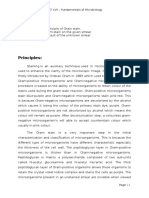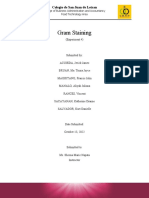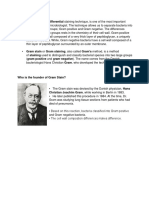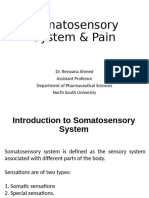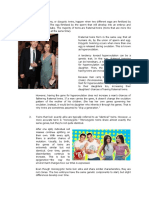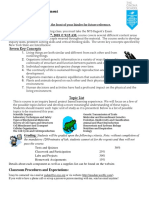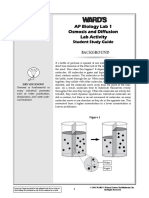Gram Staining of Bacteria Ex-4
Gram Staining of Bacteria Ex-4
Uploaded by
rayta.rahmanCopyright:
Available Formats
Gram Staining of Bacteria Ex-4
Gram Staining of Bacteria Ex-4
Uploaded by
rayta.rahmanCopyright
Available Formats
Share this document
Did you find this document useful?
Is this content inappropriate?
Copyright:
Available Formats
Gram Staining of Bacteria Ex-4
Gram Staining of Bacteria Ex-4
Uploaded by
rayta.rahmanCopyright:
Available Formats
Spring, 2024
North South University
Department of Pharmaceutical Sciences
Course: PHR124L (Pharmaceutical Microbiology-I Laboratory)
[EX-04] Title of Experiment: Gram Staining of Bacteria
Objective: The main objective of this experiment is to differentiate two large groups of bacteria based
on their different cell wall constituents.
Principle: The most important differential stain used in bacteriology is the gram stain. It is widely used
as differential staining technique which was developed by Dr. Christian Gram in 1884, and categorizes
bacteria according to their Gram character (Gram positive or Gram negative). In addition, this stain also
allows determination of cell morphology, size, and arrangement. It is typically the first differential test
run on a specimen brought into the laboratory for identification. In some cases, a rapid, presumptive
identification of the organism or elimination of a particular organism is possible.
The structure of the organism’s cell wall determines whether the organism is gram positive or negative.
The cell wall for gram positive bacteria has a higher peptidoglycan layer and lower lipid content than
gram negative bacteria. When stained with a primary stain and fixed by a mordant, some bacteria are
able to retain the primary stain by resisting decolorization while others get decolorized by a decolorizer.
Those bacteria which retain the primary stain are called Gram positive and those bacteria which get
decolorized and then get counterstained are called Gram negative.
Fig-1: The cell wall of gram Positive and Negative bacteria
Department of pharmaceutical Sciences, North South University
Spring, 2024
North South University
Department of Pharmaceutical Sciences
Course: PHR124L (Pharmaceutical Microbiology-I Laboratory)
[EX-04] Title of Experiment: Gram Staining of Bacteria
Materials:
1. Equipment: Compound Microscope and Slide
2. Stain:
➢ Crystal Violet: Act Primary a primary stain
➢ Grams Iodine: Used as a mordant
➢ Safranin: For Counter Satin
4. 95% Ethyl Alcohol (Decolorizing agent)
5. Microbial Culture
Procedure:
There are three major steps in procedure-
➢ Smear Preparation
➢ Staining of Cell (Gram Staining)
➢ Interpretation
Smear Preparation:
1. Take a grease free dry slide.
2. Sterilize the inoculating loop on a flame of a Bunsen burner.
3. Transfer a loopful of culture (or the specimen) by sterile loop and make a smear at the center.
Smear should not be very thin or very thick
4. Allow the smear to dry in the air.
5. Fix the dry smear by passing the slide 3-4 times through the flame quickly with the smear side facing
up.
Gram Staining:
1. Place the slides on the staining case.
2. Cover the smear with crystal violet stain and leave for 1 minute.
3. Wash carefully under running tap water.
4. Flood the smear with Gram’s iodine solution and leave for 1 minute.
5. Drain off the iodine Wash the slide for the again in a gentle stream of tap water.
Department of pharmaceutical Sciences, North South University
Spring, 2024
North South University
Department of Pharmaceutical Sciences
Course: PHR124L (Pharmaceutical Microbiology-I Laboratory)
[EX-04] Title of Experiment: Gram Staining of Bacteria
6. Flood the slide with the decolorizing agent (95% Ethyl Alcohol) then wait for 10-15 seconds. This can
also be done by adding a drop by drop to the slide until the decolorizing agent (95% Ethyl Alcohol)
running from the slides runs clear.
7. Gently wash the slide under running tap water and drain completely.
8. Counterstain with safranin for and and wait for about 40 seconds.
9. Wash slide in a gentile and indirect stream of tap water until no color appears in the effluent and
then blot dry with absorbent paper.
10. Observe under microscope.
Fig-2: Gram Staining
How does the stain work on Cell:
➢ Crystal violet: Crystal violet is the primary stain. It is a positive charge dye which is attracted to
the negative charge in the cell and also the thicker peptidoglycan layer helps retain the dye
more.
➢ Grams Iodine: The function of iodine solution in the gram stain is to fix the dye on the slide in
order to form insoluble substance. It also forms a complex, (sometimes called CV-I Complex)
between the crystal violet and iodine. Gram's iodine serves as a mordant; a substance that
combines with stain to enhance the staining ability.
Department of pharmaceutical Sciences, North South University
Spring, 2024
North South University
Department of Pharmaceutical Sciences
Course: PHR124L (Pharmaceutical Microbiology-I Laboratory)
[EX-04] Title of Experiment: Gram Staining of Bacteria
➢ 95% Ethyl Alcohol: Either acetone or 95% ethyl alcohol can be used as the decolorizing agent.
The alcohol dissolves lipids found in the outer cell membrane of Gram-negative bacteria,
allowing the crystal violet-iodine complex to leak out of the thinner peptidoglycan layer. The
alcohol is added for 10 to 20 seconds; it is poured on the slide until all the iodine is washed away
and the run-off is colorless. At this point in the Gram stain process, Gram-negative bacteria are
colorless while Gram-positive bacteria still retain the crystal violet. Once finished the slide needs
to be rinsed with water to stop the decolorizing effect.
➢ Safranin: The purpose of safranin in the Gram’s stain procedure is it directly stains the gram-
negative bacteria that became decolorized. The gram-positive bacteria are already stained and
not affected by the safranin.
Result/Observation:
The staining results of gram stain are as follows :
➢ Gram Positive : Dark purple
➢ Gram Negative : Light Pink to dark pink
Appearance Staining Result Name of the Bacteria
1. Shape:
2. Form:
3. Color:
Precaution:
1. Wear apron, gloves and mask.
2. Use only fresh cultures, not more than 48 hours old.
3. Don’t heat the slide more during heat fixation.
4. Don't despair if the stained smear is not visible to the naked eye; this may happen with a
Gram-negative reaction.
5. Take care to make an even smear otherwise alcohol will continue to wash the violet purple
color from thick parts of the smear while thin parts are being over-decolorized.
Department of pharmaceutical Sciences, North South University
Spring, 2024
North South University
Department of Pharmaceutical Sciences
Course: PHR124L (Pharmaceutical Microbiology-I Laboratory)
[EX-04] Title of Experiment: Gram Staining of Bacteria
Report:
Write the laboratory report for this experiment and submit it one week after the experiment to
your instructor. Remember to include the following in your report:
1. Title of the experiment
2. Purpose/objective
3. Materials required
4. Procedure
5. Result/Observation
6. What you have learned from this experiment
7. Precaution
Department of pharmaceutical Sciences, North South University
You might also like
- Chapter 2-Palao - Lab Report - Gram StainingDocument3 pagesChapter 2-Palao - Lab Report - Gram StainingBlethy April PalaoNo ratings yet
- Gram StainingDocument4 pagesGram StainingmaryannekijoNo ratings yet
- Lab ReportDocument24 pagesLab Reportwol aldo0% (1)
- Lab Exercise 6 SIMPLE STAININGDocument5 pagesLab Exercise 6 SIMPLE STAININGArianne Jans MunarNo ratings yet
- Gram Stain Procedure and Additional Information - Practical 1Document6 pagesGram Stain Procedure and Additional Information - Practical 1kamvajavasNo ratings yet
- IFU Gram StainDocument5 pagesIFU Gram StainChandra MohanNo ratings yet
- SBL 1023 Lab 9 Exp Gram Staining AsepticDocument10 pagesSBL 1023 Lab 9 Exp Gram Staining Asepticapi-384057570No ratings yet
- MCB 202 Lecture NoteDocument18 pagesMCB 202 Lecture NotewretyitNo ratings yet
- Gram Decolorizer (95% Ethyl Alcohol) : Adjusted As Required To Meet Performance StandardsDocument1 pageGram Decolorizer (95% Ethyl Alcohol) : Adjusted As Required To Meet Performance StandardsBhabani DasNo ratings yet
- Gram Staining of BacteriaDocument3 pagesGram Staining of Bacteriadavid5king-3119No ratings yet
- Gram Staining LaboratoryDocument3 pagesGram Staining Laboratorybiancaarabila.loboNo ratings yet
- LAB 2: Staining and Streaking: Series of Stains and Chemical Reagents To Increase Contrast and Reveal Information AboutDocument10 pagesLAB 2: Staining and Streaking: Series of Stains and Chemical Reagents To Increase Contrast and Reveal Information AboutrabkaNo ratings yet
- Gram StainDocument7 pagesGram StainYani ManuelNo ratings yet
- Final ManualDocument24 pagesFinal Manualfattima.afzal456No ratings yet
- Basic Microbiology Lab Reporting Gram StainingDocument26 pagesBasic Microbiology Lab Reporting Gram StainingNeayzahn AcesSka100% (1)
- 112 Ex3Document20 pages112 Ex3Francis SullanoNo ratings yet
- Microbiology ExperimentDocument9 pagesMicrobiology Experiment门门No ratings yet
- Activity 4 Gram StainingDocument2 pagesActivity 4 Gram StainingujargohandiNo ratings yet
- Micro LabDocument6 pagesMicro LabNser SeyamNo ratings yet
- BIOL 2P98 D2 2017FW Lab 4Document18 pagesBIOL 2P98 D2 2017FW Lab 4TumuhimbiseMosesNo ratings yet
- Staining Bacteria and MicroscopeDocument9 pagesStaining Bacteria and MicroscopeNur Athirah KhairinaNo ratings yet
- Post LabDocument3 pagesPost LabQueenie CalambaNo ratings yet
- Identification of Bacteria Using Gram Staining MethodDocument7 pagesIdentification of Bacteria Using Gram Staining MethodDani MughalNo ratings yet
- MLT 415 Lab Report Gram Stain TechniquesDocument7 pagesMLT 415 Lab Report Gram Stain TechniquesYo YaNo ratings yet
- Learn Microbiology Online Medical Microbiology Guide: News TickerDocument19 pagesLearn Microbiology Online Medical Microbiology Guide: News TickerCecilia MukototsiNo ratings yet
- Gram Stain Lab 1Document1 pageGram Stain Lab 1m18350248No ratings yet
- Laboratory Exercise 3 MicroDocument13 pagesLaboratory Exercise 3 MicroRose An CorbillonNo ratings yet
- Exp#5 Gram StainingDocument4 pagesExp#5 Gram StainingbahadiroztenNo ratings yet
- Biochemical TestsDocument12 pagesBiochemical TestsgebrushsankiNo ratings yet
- (General Microbiology) Lab Rep 4 - Gram StainingDocument15 pages(General Microbiology) Lab Rep 4 - Gram StainingFrancis MagbitangNo ratings yet
- Exercise 8Document3 pagesExercise 8Merve Nur GülerNo ratings yet
- 4 TH WeekDocument5 pages4 TH Weekfifty shades of coffeeNo ratings yet
- Sample Lab Report - Spring - 2021Document3 pagesSample Lab Report - Spring - 2021ariana villarrealNo ratings yet
- Staining TechniquesDocument10 pagesStaining TechniquesJohn Emmanuel TayagNo ratings yet
- Staining Techniques in Microbiology.Document9 pagesStaining Techniques in Microbiology.rajendraprasadreddyNo ratings yet
- Microbiology Module 3-1Document8 pagesMicrobiology Module 3-1randhie hakimNo ratings yet
- Identifying Microbes Staining, DPA 200-2-1Document21 pagesIdentifying Microbes Staining, DPA 200-2-1Yeboah Kukudabi AsiamahNo ratings yet
- Lab Bio 301 - 1Document5 pagesLab Bio 301 - 1Nur AthirahNo ratings yet
- Staining, Bacteria, and Use of The MicroscopeDocument9 pagesStaining, Bacteria, and Use of The MicroscopeHusna AliasNo ratings yet
- BI103 Practical 2 HandoutDocument5 pagesBI103 Practical 2 HandoutStephane FongNo ratings yet
- Activity 2 - Gram Staining - GR 4Document6 pagesActivity 2 - Gram Staining - GR 4leenquishayuNo ratings yet
- MicroPara Worksheet 5Document7 pagesMicroPara Worksheet 5Enguio Irish JeanNo ratings yet
- AbstractDocument4 pagesAbstractAzeelia Sonia BayangNo ratings yet
- Activity 2 Gram StainDocument5 pagesActivity 2 Gram StainDivina Gracia Vibal CieloNo ratings yet
- Cell Staining: The Simple StainDocument4 pagesCell Staining: The Simple StainAitlas KhanNo ratings yet
- Laboratory Report 2 - Gram Staining PakshetDocument9 pagesLaboratory Report 2 - Gram Staining PakshetMaica Kristine DicionNo ratings yet
- Adlina Firza Module 6 Group 4 IUPDocument9 pagesAdlina Firza Module 6 Group 4 IUPdhani7No ratings yet
- FST-305 Cereal Milling & LegumesDocument2 pagesFST-305 Cereal Milling & LegumesRishav GautamNo ratings yet
- Assignment Gram Stain.111Document6 pagesAssignment Gram Stain.111premium Shopping centreNo ratings yet
- Gram StainDocument13 pagesGram StainAnonymous RuHCQwo7No ratings yet
- Lab 5 Microbiology sbl1023Document9 pagesLab 5 Microbiology sbl1023api-385038701100% (1)
- Exp 1Document2 pagesExp 1Dibyajyoti20 Das4001No ratings yet
- Worksheet 1 Microscopic Visualization of Bacteria Differential and Structural StainingDocument6 pagesWorksheet 1 Microscopic Visualization of Bacteria Differential and Structural StainingKyra ErniNo ratings yet
- Universiti Sains Malaysia Jib 221 Microbiology Practical 2. Simple Stain and Gram Stain TechniquesDocument3 pagesUniversiti Sains Malaysia Jib 221 Microbiology Practical 2. Simple Stain and Gram Stain TechniquesBaby girlNo ratings yet
- Sample Staining Ex-3Document3 pagesSample Staining Ex-3rayta.rahmanNo ratings yet
- Staining TechniquesDocument9 pagesStaining Techniquesjaysand08No ratings yet
- Staining MethodsDocument8 pagesStaining MethodsMd Arshad100% (1)
- 4 Microbiology Lab Report Practical 3 PDFDocument10 pages4 Microbiology Lab Report Practical 3 PDFNurul IzzahNo ratings yet
- LABORATORY MANUAL FOR A MINI PROJECT: MSCB 1113 BIOCHEMISTRY & MICROBIAL PHYSIOLOGYFrom EverandLABORATORY MANUAL FOR A MINI PROJECT: MSCB 1113 BIOCHEMISTRY & MICROBIAL PHYSIOLOGYNo ratings yet
- Zebrafish: Methods for Assessing Drug Safety and ToxicityFrom EverandZebrafish: Methods for Assessing Drug Safety and ToxicityPatricia McGrathNo ratings yet
- Lec-5 ANS New NewDocument43 pagesLec-5 ANS New Newrayta.rahmanNo ratings yet
- Lec-4 New New Somatosensory & PainDocument24 pagesLec-4 New New Somatosensory & Painrayta.rahmanNo ratings yet
- NSU GI Agents NewDocument57 pagesNSU GI Agents Newrayta.rahmanNo ratings yet
- 008 Evaluation of Crude DrugsDocument16 pages008 Evaluation of Crude Drugsrayta.rahmanNo ratings yet
- Lab Performance Paper - Exp 5 - Functional Group TestDocument1 pageLab Performance Paper - Exp 5 - Functional Group Testrayta.rahmanNo ratings yet
- Lec-6 Endocrine System OverviewDocument35 pagesLec-6 Endocrine System Overviewrayta.rahmanNo ratings yet
- Microscopic Observation Ex-2Document9 pagesMicroscopic Observation Ex-2rayta.rahmanNo ratings yet
- Lec-5 ANS New NewDocument38 pagesLec-5 ANS New Newrayta.rahmanNo ratings yet
- Lecture 7 ReKm Normal DistributionDocument9 pagesLecture 7 ReKm Normal Distributionrayta.rahmanNo ratings yet
- Laudon Mis17 PPT ch10Document39 pagesLaudon Mis17 PPT ch10rayta.rahmanNo ratings yet
- Virgen Milagrosa University Foundation: COLLEGE of NursingDocument27 pagesVirgen Milagrosa University Foundation: COLLEGE of NursingGenierose YantoNo ratings yet
- Ozone Therapy: A Clinical ReviewDocument5 pagesOzone Therapy: A Clinical ReviewSteveNo ratings yet
- The Strecker Group Reference ListDocument7 pagesThe Strecker Group Reference ListJohn Burns100% (1)
- Springer Protocols Handbooks M Tofazzal Islam Pankaj K Bhowmik Kutubuddin A Molla - CRISPR-Cas Methods-Springer US 20Document288 pagesSpringer Protocols Handbooks M Tofazzal Islam Pankaj K Bhowmik Kutubuddin A Molla - CRISPR-Cas Methods-Springer US 20Никита Ваулин100% (1)
- Paper 2Document16 pagesPaper 2Ivana EstechoNo ratings yet
- Pines EmbryologyDocument5 pagesPines Embryologychris jacobNo ratings yet
- Bio Eoc Review Session 1 Questions 11-12Document6 pagesBio Eoc Review Session 1 Questions 11-12api-269873615No ratings yet
- The Viral ReplicationDocument1 pageThe Viral ReplicationlmreginioNo ratings yet
- Science: Quarter 2 - Module 6Document27 pagesScience: Quarter 2 - Module 6edelberto100% (2)
- BM6504 Bio Potential Electrodes: Biopotentials Ms.B.Divya Ap/BmeDocument27 pagesBM6504 Bio Potential Electrodes: Biopotentials Ms.B.Divya Ap/BmePrasidha PrabhuNo ratings yet
- Regent's Living Environment: Seven Key ConceptsDocument6 pagesRegent's Living Environment: Seven Key Conceptsapi-260733680No ratings yet
- Foote CVDocument9 pagesFoote CVRavindr KumarNo ratings yet
- Human Genetics Traits LabDocument5 pagesHuman Genetics Traits LabFaisa DaoudNo ratings yet
- 07 Control of Gene Expression in ProkaryotesDocument17 pages07 Control of Gene Expression in Prokaryotesmustafa aliNo ratings yet
- Virus Structure ClassificationDocument9 pagesVirus Structure Classification007ginniNo ratings yet
- Apoptosis in Selected Skin Diseases PDFDocument9 pagesApoptosis in Selected Skin Diseases PDFDiana Gabriela GutuerrezNo ratings yet
- StemsDocument4 pagesStemsGaea HillNo ratings yet
- FLIBase A Comprehensive Repository of Full-Length Isoforms Across Human Cancers and TissuesDocument10 pagesFLIBase A Comprehensive Repository of Full-Length Isoforms Across Human Cancers and TissuesLau Yu XuanNo ratings yet
- YDS Read and Comprehend AIDSDocument3 pagesYDS Read and Comprehend AIDSAzat CanNo ratings yet
- Chromosomal AbnormalitiesDocument61 pagesChromosomal AbnormalitiesManisanthosh Kumar100% (1)
- Diffusion & Osmosis LabDocument17 pagesDiffusion & Osmosis LabDee Mar0% (1)
- G-Protein Coupled Receptors and Their Signaling MechanismDocument21 pagesG-Protein Coupled Receptors and Their Signaling Mechanismaroob9mahamoodaurinNo ratings yet
- Lynn Margulis - Celeste A. Asikainen - Wolfgang E. Krumbein - Chimeras and Consciousness - Evolution of The Sensory Self-MIT Press (MA) (2011)Document339 pagesLynn Margulis - Celeste A. Asikainen - Wolfgang E. Krumbein - Chimeras and Consciousness - Evolution of The Sensory Self-MIT Press (MA) (2011)Emmanuel AlmadaNo ratings yet
- Chapter 77protozoaDocument11 pagesChapter 77protozoaduraiakilaNo ratings yet
- All Living Things Are Made of Cells Are The Basic Unit of in An Organism (Basic Unit of Life) Cells Come From The (Cell Division)Document10 pagesAll Living Things Are Made of Cells Are The Basic Unit of in An Organism (Basic Unit of Life) Cells Come From The (Cell Division)Christine EvangelistaNo ratings yet
- Enzymes Used in RDT Corrected Version EditedDocument43 pagesEnzymes Used in RDT Corrected Version EditedYuppie RajNo ratings yet
- Dynamic Programming Methods in Pairwise AlignmentDocument41 pagesDynamic Programming Methods in Pairwise AlignmentPriyanshu PandaNo ratings yet
- Practical 1 Lab Report BIO301 PDFDocument5 pagesPractical 1 Lab Report BIO301 PDFfar50% (2)
- Ernst Mayr One Long Argument PDFDocument2 pagesErnst Mayr One Long Argument PDFDanNo ratings yet
- MT6315Document13 pagesMT6315Ham BurgerNo ratings yet























